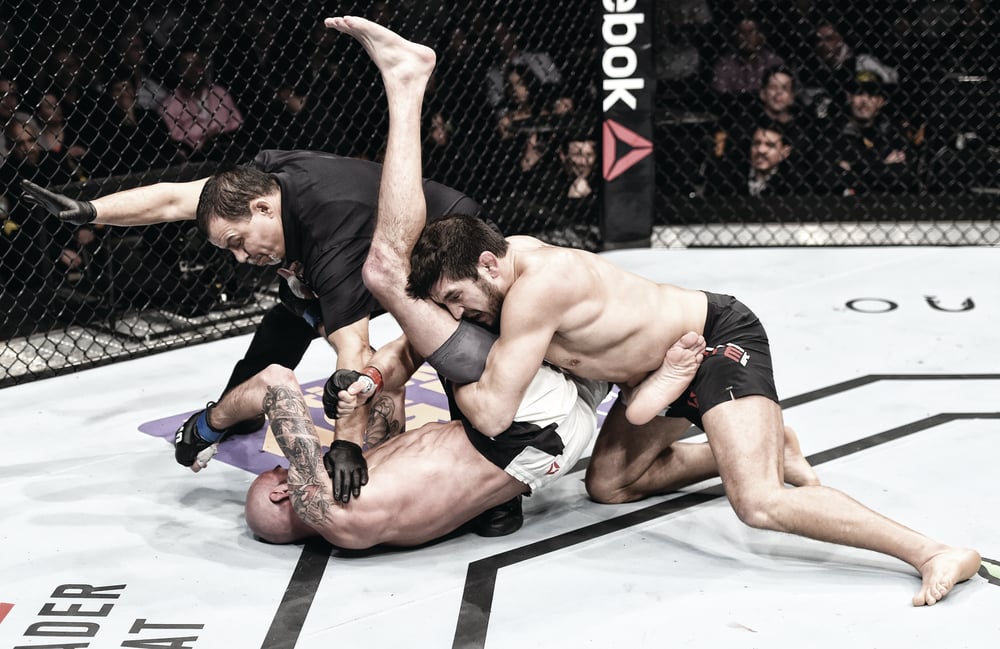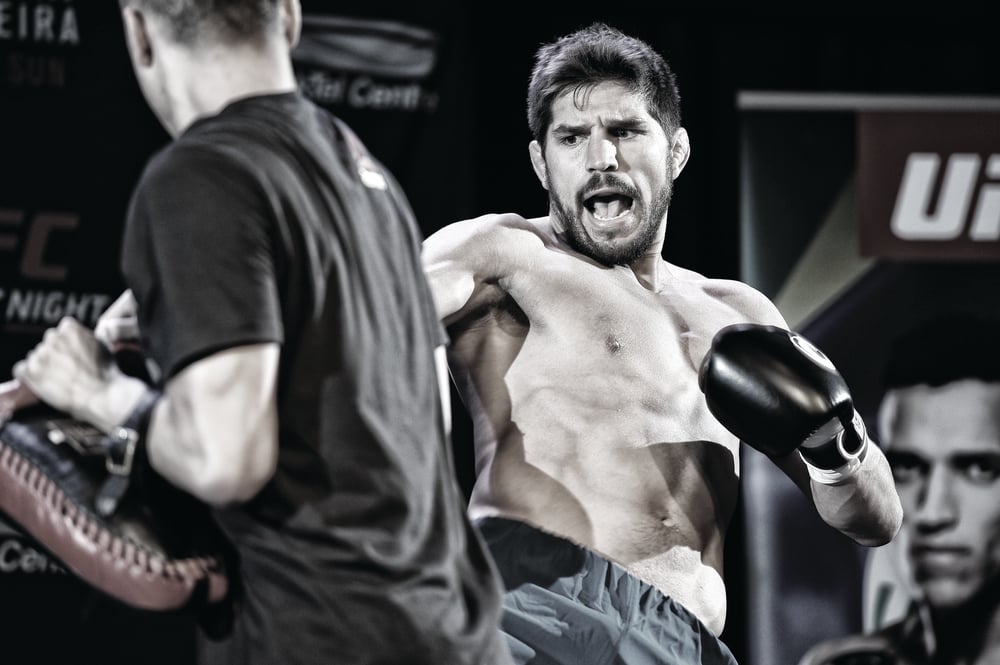
Issue 142
June 2016
Patrick Cote’s welterweight resurgence has secured his status as Canada’s comeback king and put him on the cusp of UFC history
Patrick Cote
UFC Welterweight
Alias: The Predator
Age: 36
Team: Brazilian Top Team Canada
Record: 23-9
The new and improved Patrick Cote isn’t back to his best. The slimmed-down 2016 version of the former 185lb title challenger is the fastest, strongest and most powerful incarnation of ‘The ‘Predator’ there’s ever been. His granite chin is still intact, knockouts are exploding from his fists once again and he’s finally added his BJJ black belt box of tricks to his Octagon encounters to fight with a complete MMA game. He might be coming to the end of his career, but he’s still on the hunt for one more title shot in the sport’s toughest division.
What’s the story behind your most successful run in the UFC?
A Since I dropped to 170 I’ve had a second life in my career. I’m just fighting because I want to and not because I need to, so it’s 10 times less stressful for me to go in the cage and fight because if I stopped fighting today I wouldn’t change my lifestyle. I have a real-estate company, I’m working on French TV here in Montreal – everything’s going very well for after my fighting career.
And it’s the experience. I have more now after 15 years in mixed martial arts. I’m having fun, enjoying the moment and trying a lot of things I didn’t try before in the fights – just because I didn’t have the guts to try them (before). It’s totally another mentality. I’m still passionate and the major thing is I want to have fun.
Is there any secret behind the development of your grappling?
A Fabio Holanda (Brazilian Top Team Canada head coach) is a major part of my success and he always believed in me. My career was always a bit like a roller coaster. I had a very high point in my career and I went back to a very low point, but I always came back and Fabio is a big factor in that. I always had jiu-jitsu before, I always trained wrestling, but I didn’t have the confidence to try them in a real fight.
I’m a BJJ black belt. I’ve been training jiu-jitsu for more than 10 years so I thought, ‘Why not? I know jiu-jitsu, so let’s try it and we’ll see what happens.’ In my last couple of fights I’ve used more grappling, I’ve tried some submissions and I’m not afraid to try moves that might have put me in bad positions any more. I know I’m not going to be in danger. I’m going to be able to get out of them.

You went seven-an-a-half years without a knockout in the UFC, so what’s helped you hit two in consecutive fights?
A It’s Fabio again. Fabio always told me, ‘I know you want to focus on your jiu-jitsu and wrestling but don’t forget you are a striker. You have to continue your boxing. You have to upgrade your standup skills. It’s your strength. You have to be the most complete athlete possible in this game.’ Now I’m adding jiu-jitsu and wrestling skills in the real fight – it’s going to put doubts in the minds of my opponents. They have to be more prepared because the fight can go anywhere.
Before everyone was just training to avoid my standup game, so it was hard to knock people out. They knew I would only count on one-punch knockouts so it was easier for them to have a game plan to avoid that. With the other tools they have to think about more options and I’m able to put my fists in their face again and get the knockouts.
You’re well known for your granite chin, which still holds up after 15 years of fighting, but do you fear it may fail you one day?
A I understand that when you have a good chin, you have to protect it. It’s going to save your life when you go through a big exchange with a heavy hitter. When I fought Chris Leben I had that mentality. I knew I had a good chin and capacity to take a punch. Like you saw in my last four fights, I fight smarter. I’m not getting into too many toe-to-toe exchanges, trying to prove I have a better chin than my opponent. My fighting style changed.
I’ve never been knocked down in my life except against (Alessio) Sakara, but that was a punch on the back of my head. I’ve been clipped, but I’ve never been rocked or dizzy from a punch. I know I’m lucky I’ve got a good chin, but I’m not tying to overexpose it. I made my name in this sport and I don’t have to go through a toe-to-toe war to prove I belong in the UFC. I did many wars in my career. I’ve proved I can go toe-to-toe with anyone at 185 and now 170.
Did you have any doubts when you were cut by the UFC in 2010?
A I had big doubts when I lost my fight against Tom Lawlor. Two fights before I was fighting for the middleweight title, I got hurt, it took me a year-and-a-half to come back to competition and I came back with two losses in a row. I didn’t go to the gym at all for three months. Then I told myself, ‘OK, now I’m going to know if the fire is back or I still want to make the sacrifices to do this sport.’ I went back to the gym and I wanted to do that again. After that I worked my ass off to get back to the big show. I won four fights in a row – two knockouts – and they called me to come back against Cung Le. That was a big fight right away. I lost again to a top fighter at that time, but I was a short-notice replacement so I was able to get back on a winning streak and here I am now.

Why do you think you were able to return to the UFC so quickly?
A I always had a good relationship with the UFC because my first fight was against Tito (Ortiz, at UFC 50). I kind of saved that main event because everyone wanted to see Tito. Nobody cared about me at that time (laughs). I understood very fast they’re your boss before they’re your friends, so you have to work very hard to keep your place there. It’s a business and if you don’t win fights it’s your fault. It’s not their fault they have to cut you. At the same time they were very clear with me. They told me what to do to come back and that’s what I did.
Who would you like to be matched up against now?
A Right now, with the mentality I have, anybody. I wanted to fight Matt Brown because that could be a very good fight for the fans. It could be ‘Fight of the Night’ for sure. The goal is always to be the best in the world, so my goal right now is to move up in the rankings and get another title fight. But I will be very happy to go with 22 fights in the UFC. I’d be the Canadian with the most fights in the UFC. That can be a good thing to put my name in history if I’m not going to be a world champion. Georges (St Pierre) has 21, I’m on 19 now, so if I fight three more times – and Georges doesn’t come back (laughs)… We’ll see what happens.
Would you then retire, after you’ve claimed that record?
A I’m enjoying what I’m doing, my body’s feeling good, it’s not dangerous for my health and I’m still able to compete at this level. I can’t see why I’d stop. I love what I’m doing. Somebody pays me to be in good shape and that’s a very good life, trust me. At the same time, I’ve had 11 surgeries on my knees, shoulders, elbows, hands… Right now I feel good but you never know. Next year my body might feel 70 years old. I’m taking one fight at a time.
10-9
Winning track
Cote’s first fight in the UFC was almost 12 years ago, but now, finally, he has a winning record in the Octagon. He’s scheduled to attempt to take his win tally to 11 against Donald Cerrone in Ottawa on June 18th.
Full-time tutor
Q After leading Team Canada to victory on The Ultimate Fighter, do you want to be a coach when you retire?
A. I’ll be interested to coach someone who knows what they’re doing. I don’t have the patience to start a guy from nothing (laughs). I will lose my time and the guy will lose his time too. I don’t have the capacity to be a good teacher like that. Cornering some guys, giving advice, taking some seminars – I will love it – but having a school is never going to happen. I’m more interested in starting my own management company in two or three years. I’ve been on the fighter’s side, I have a good relationship with a lot of promoters in Canada and the UFC, so I could be a really good manager.
...









